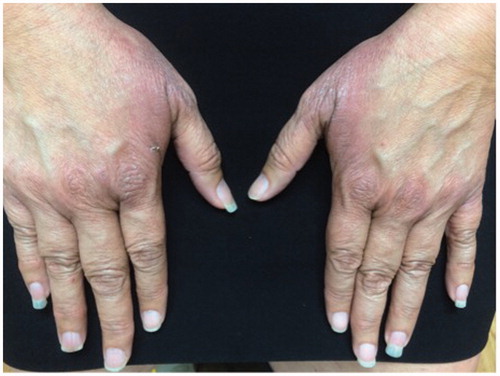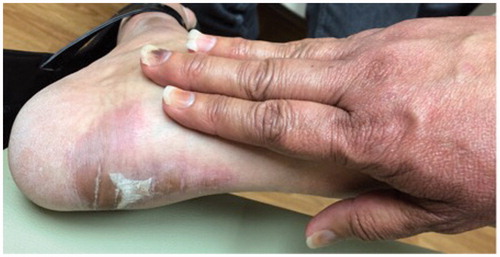Introduction
Periarticular thenar erythema with onycholysis (PATEO) syndrome, a subtype of hand-foot syndrome first defined by Childress and Lokich [Citation1], is a rare cutaneous toxicity that may manifest in patients undergoing treatment with paclitaxel or docetaxel. In contrast to hand-foot syndrome, PATEO syndrome is characterized by: (1) palmar erythema mainly over the thenar and hypothenar eminences; (2) violaceous coloration predominantly of the dorsum of the hands, especially over the joints of the hands and around the Achilles tendon area and (3) nail changes that frequently progress to onycholysis. We present a patient undergoing treatment with taxane-based chemotherapy who despite developing PATEO syndrome was able to continue her treatment thanks to adequate dermatologic management.
Case report
A 54-year-old woman undergoing chemotherapy for breast cancer developed a pruritic, burning eruption on the hands and feet after her sixth infusion of paclitaxel. She had previously been using 1% hydrocortisone cream on the site with minimal relief. Physical examination revealed erythematous-violaceous scaly plaques on the dorsal hands () and over the right Achilles tendon () and development of onycholysis and subungual hemorrhages on the nails (). The patient was diagnosed with periarticular thenar erythema with onycholysis (PATEO) syndrome secondary to paclitaxel. She began treatment with fluocinonide 0.05% ointment twice daily, was counseled to soak the nails in diluted vinegar and was also advised to keep her hands cooled in ice baths during subsequent paclitaxel infusions. Her cutaneous symptoms improved within five weeks of diagnosis and she was able to finish her chemotherapy regimen without any need for dose reduction.
Discussion
Although the pathophysiologic mechanism leading to PATEO syndrome is largely unknown, the severity of this cutaneous manifestation is thought to be related to dosing interval and the cumulative number of chemotherapy cycles [Citation1,Citation2]. Even though nail and skin toxicity are not life threatening, effective management to ameliorate the symptoms is a necessity to allow patients to continue their chemotherapy regimen. In some cases, patients may require dose adjustment, as was the case in a series of three patients with PATEO syndrome described by Rodriguez-Lomba et al. [Citation3] Despite development of PATEO syndrome, our patient was able to continue her chemotherapy regimen with use of a potent topical corticosteroid and cooling her hands in ice baths during subsequent paclitaxel infusions, an approach similar to Scotté et al’s [Citation4,Citation5] frozen glove therapy that was found to significantly reduce nail and skin toxicity associated with taxane-based chemotherapy. We present this case to heighten awareness of this unique manifestation of hand-foot syndrome specific to taxane chemotherapy and share a successful approach towards management.
Disclosure statement
No potential conflict of interest was reported by the authors.
References
- Childress J, Lokich J. Cutaneous hand and foot toxicity associated with cancer chemotherapy. Am J Clin Oncol. 2003;26:435–436.
- Dow EN, Piccolo J, Segal EM, et al. Drug induced periarticular thenar erythema with onycholysis related to nano-albumin bound paclitaxel therapy. Cancer Treat Commun. 2015;4(Supplement C):161–164.
- Rodríguez-Lomba E, Molina-López I, Suárez-Fernández R, et al. Periarticular thenar erythema and onycholysis syndrome: a manifestation of taxane-induced cutaneous toxicity. Actas Dermo-Sifiliográficas Engl Ed. 2017;108:595–597.
- Scotté F, Tourani JM, Banu E, et al. Multicenter study of a frozen glove to prevent docetaxel-induced onycholysis and cutaneous toxicity of the hand. J Clin Oncol off J Am Soc Clin Oncol. 2005;23:4424–4429.
- Scotté F, Banu E, Medioni J, et al. Matched case-control phase 2 study to evaluate the use of a frozen sock to prevent docetaxel-induced onycholysis and cutaneous toxicity of the foot. Cancer. 2008;112:1625–1631.


